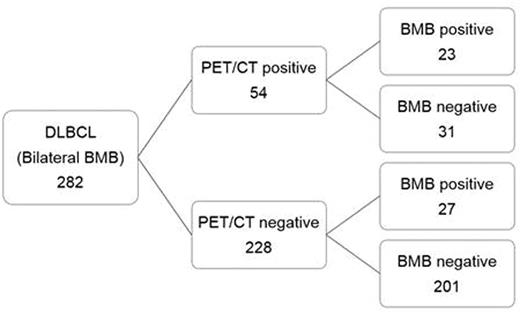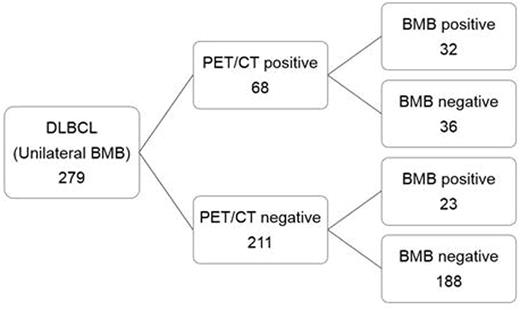Abstract
Background
Bone marrow biopsy (BMB) has been recommended for all patients with newly diagnosed diffuse large B-cell lymphoma (DLBCL) to detect bone marrow involvement in the staging workup for decades. No clear consensus, however, is reached regarding whether bilateral BMB is required for all patients or unilateral BMB is sufficient. Moreover, a number of studies have reported positron emission tomography combined with computed tomography (PET/CT) to be accurate enough to replace BMB for the detection of bone marrow involvement and the use of PET/CT in place of BMB has been consistently increasing. However reported results assessing the roles of BMB and PET/CT in the staging of the BM have been contradictory and controversial. Therefore, we investigated the difference between unilateral and bilateral BMB in the diagnostic value of DLBCL and how they are respectively correlated to PET/CT findings.
Method
A registry data set, prospectively collected at a single institution, Asan Medical Center (AMC), was retrospectively reviewed. Bone marrow biopsy and aspirate were performed bilaterally from September 2012 to September 2014 (n=282) and unilaterally from September 2014 to May 2016 (n=279).
The sensitivity, specificity, positive predictive value (PPV), and negative predictive value (NPV) of PET/CT were analyzed. Ann Arbor stage was determined using PET/CT with and without the contribution of BMB, and the proportion of stage IV cases by each method was calculated.
Result
A total of 561 patients were analyzed and all patients had evaluated BM involvement by PET/CT, of which 282 patients and 279 patients underwent unilateral and bilateral BMB, respectively. Bone marrow involvement was identified in 50 of 282 patients (17.7%) based on bilateral BMB and in 55 of 279 patients (19.7%) on unilateral BMB. In bilateral BMB group, 18 of 50 patients had unilateral involvement of bone marrow. The yield of unilateral BMB was not inferior to that of bilateral BMB. (p=0.547)
In bilateral BMB group, PET/CT identified BM involvement by with sensitivity 46%, specificity 86.6%, PPV 42.6%, and NPV 88.2%. In unilateral BMB group, sensitivity 58.2%, specificity 83.9%, PPV 47.1%, and NPV 89.1%. (figure 1,2)
BMB did not show statistically significant differences in the contribution to upstaging to stage IV in neither bilateral nor unilateral BMB group (p=0.513). Ann Arbor stage according to diagnostic modality is shown in table 1.
Conclusion
Unilateral BMB showed a similar yield compared to bilateral BMB and the likelihood of upstaging was also comparable between the two groups. Additionally the NPV of PET/CT was shown to be high as reported in previous studies. Our results suggest that unilateral BMB may replace bilateral BMB in patients with DLBCL whereas unilateral BMB might not be necessary for routine staging procedures in patients without BM involvement in PET/CT findings.
(Case distribution of bone marrow status assessed by PET/CT and BM biopsy in patients with bilateral BMB)
(Case distribution of bone marrow status assessed by PET/CT and BM biopsy in patients with bilateral BMB)
(Case distribution of bone marrow status assessed by PET/CT and BM biopsy in patients with unilateral BMB)
(Case distribution of bone marrow status assessed by PET/CT and BM biopsy in patients with unilateral BMB)
(Ann Arbor stage according to diagnostic modality in both groups of patients.)
No relevant conflicts of interest to declare.
Author notes
Asterisk with author names denotes non-ASH members.




This feature is available to Subscribers Only
Sign In or Create an Account Close Modal